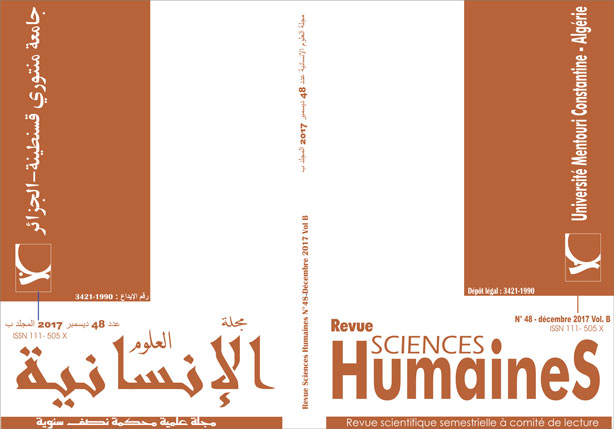A Word-frequency Based Assessment of English as a Foreign Language Master One Students' Written Receptive and Productive Lexical Knowledge
Keywords:
Word-frequency, assessment, English, Foreign Language, Master, Students' Written Receptive, Productive, Lexical, KnowledgeAbstract
Learning an adequate knowledge of words is a prerequisite for linguistic mastery. The present study was basically carried out to quantitatively evaluate EFL Master One students’ lexical knowledge. Its main objective was to assess and compare learners’ receptive and productive written word knowledge as two prominent dimensions of a person's vocabulary knowledge recognised in many lexical researches. The study deployed two well-known frequency-based assessment tools. The first was the Vocabulary Size Test (VST) employed to measure the participants’ abilities to recognize and comprehend meanings of forms at different frequency levels within given limited contexts. The second was the Productive Vocabulary Levels Test (PVLT) primarily used to assess the participants' abilities to retrieve and produce lexical items of varying frequency levels within diverse contexts. The two tests were taken by a randomly chosen sample of 40 first year Master One students at the Department of English at the University of Constantine 1. The results of the VST revealed that the majority of the participants’ receptive vocabulary sizes ranged between 5,000 and 8,000 word families, sizes classified as mid-frequency vocabulary. The data collected from the PVLT, comparatively, revealed a poor mastery of the participants’ abilities to use words productively in diverse contexts. Accordingly, the highest scores were achieved only in using the high-frequency vocabulary, and then they sharply decreased at lower frequency levels. Keywords: lexical proficiency, vocabulary receptive knowledge, vocabulary productive knowledge, frequency-levels, vocabulary size.
Downloads
References
Carter, R. (1998). Vocabulary: Applied Linguistic Perspectives. (2nd Ed). London: Routledge.
Corson, D. (1995). Using English Words. Dordrecht: Kluwer Academic Publishers.
Decarrico, J. S. (2001). Vocabulary Learning and Teaching. In M. Celce-Murcia (Ed). Teaching English as a Second of Foreign Language (pp. 285-299). Boston, MA: Heinle & Heinle.
Daller, H., Milton, J., Treffers-Daller, J. (2007). Modelling and Assessing Vocabulary Knowledge. Cambridge: Cambridge University Press.
Giannoni, D.S. & Ciarlo, C. (2012). Measuring L2 Receptive and Productive Vocabulary Knowledge. Language Studies Working Papers, 4(2040-3461), 37-45.
Goulden, R., Nation, P., & Read, J. (1990). How Large can a Receptive Vocabulary Be?, Applied Linguistics, 11, 341-362.
Laufer, B. (1998). The Development of Passive and Active Vocabulary in Second Language: Same or Different?, Applied Linguistics, 19, 255-272.
Laufer, B., & Nation, P. (1999). A Vocabulary Size Test of Controlled Productive Ability. Language Testing, 16(1), 36-55.
McCarthy, M., O’Keeffe, A., & Walsh, S. (2010). Vocabulary Matrix - Understanding, Learning, Teaching. Hampshire: Heinle, Cengage Learning.
Meara, P. (1990). A Note on Passive Vocabulary. Second Language Research, 6(2), 150-154.
Meara, P. (1996). The Dimensions of Lexical Competence. In G. Brown, K. Malmkjaer, & J. Williams (Eds). Performance and Competence in Second Language Acquisition (pp. 53-52). Cambridge: Cambridge University Press.
Nation, P., & Waring, R. (1997). Vocabulary Size, Text Coverage and Word Lists. In N. Schmitt & M. McCarthy (Eds.), Vocabulary: Description, Acquisition and Pedagogy. Cambridge: Cambridge University Press.
Nation, I. S. P. (2000). Learning Vocabulary in Another Language. Cambridge: Cambridge University Press
Nation, I. S. P. (2006). How Large a Vocabulary is Needed for Reading and Listening? Canadian Modern Language Review, 63(1), 59-82.
Nation, P. & Beglar, D. (2007). A Vocabulary Size Test. The Language Teacher, 31(7). 9-13.
.Read, J. (1988). Measuring the Vocabulary Knowledge of Second Language Learners. RELC Journal, 19(2), 12-25.
Read, J. (2000). Assessing Vocabulary. Cambridge: Cambridge University Press.
Schmitt, N. (2000). Vocabulary in Language Teaching. Cambridge: Cambridge University Press.
Schmitt, N., Schmitt, D., & Clapham, C. (2001). Developing and Exploring the Behaviour of Two New Versions of the Vocabulary Levels Test. Language Testing, 18(1), 55-88.
Webb, S., & Paribakht, T. S. (2015). What Is the Relationship Between the Lexical Profile of Test Items and Performance on a Standardized English Proficiency Test? English for Specific Purposes, 38, 34-43.
Wilkins, D. A. (1972). Linguistics in Language Teaching. London: Edward Arnold.















